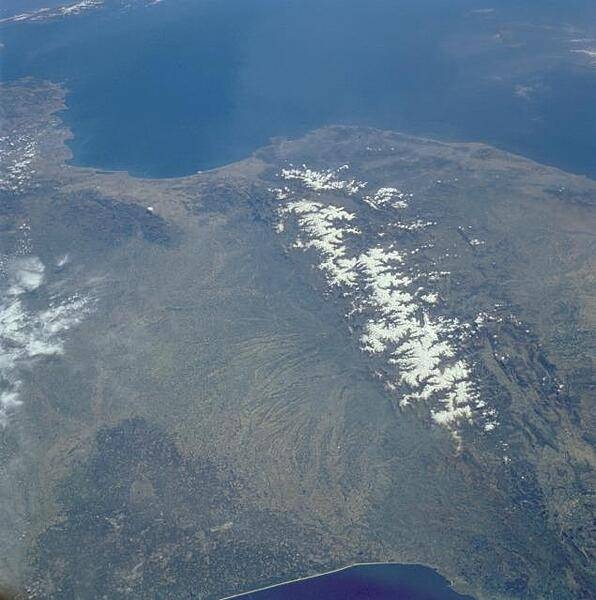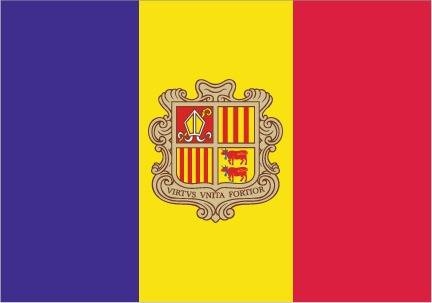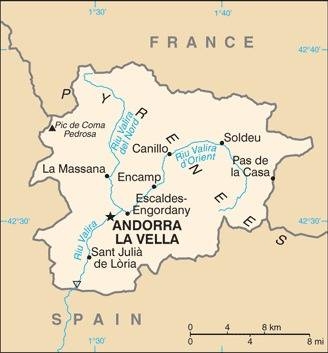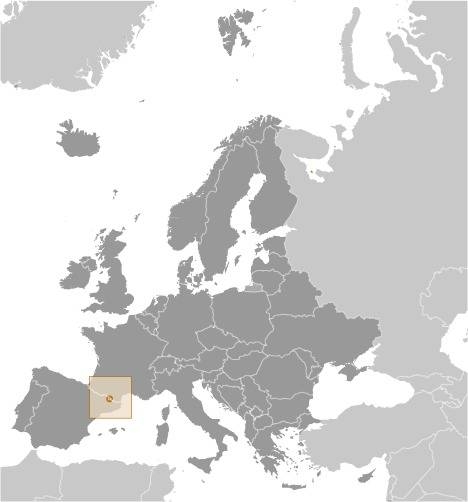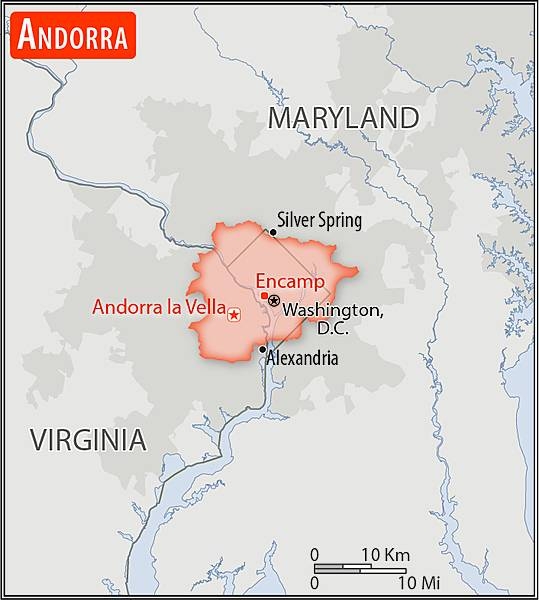Andorra
Introduction
Background
The Moorish invasion of Spain in the 8th century and subsequent incursions into France were finally stemmed at the Pyrenees by Frankish King Charlemagne, who in 795 created the Hispanic March, a series of buffer states to keep the Muslim Moors from advancing into Christian France. The landlocked Principality of Andorra, one of the smallest states in Europe and nestled high in the Pyrenees between the French and Spanish borders, is the last independent survivor of these March states. For 715 years, from 1278 to 1993, Andorrans lived under a unique coprincipality, ruled by French and Spanish leaders (from 1607 onward, the French chief of state and the Bishop of Urgell). In 1993, this feudal system was modified with the introduction of a modern constitution; the co-princes remained as titular heads of state, but the government transformed into a parliamentary democracy.
Andorra has become a popular tourist destination visited by approximately 8 million people each year drawn by the winter sports, summer climate, and duty-free shopping. Andorra has also become a wealthy international commercial center because of its mature banking sector and low taxes. As part of its effort to modernize its economy, Andorra has opened to foreign investment, and engaged in other reforms, such as advancing tax initiatives aimed at supporting a broader infrastructure. Although not a member of the EU, Andorra enjoys a special relationship with the bloc that is governed by various customs and cooperation agreements and uses the euro as its national currency.
Visit the Definitions and Notes page to view a description of each topic.
Geography
Location
Southwestern Europe, Pyrenees mountains, on the border between France and Spain
Geographic coordinates
42 30 N, 1 30 E
Map references
Europe
Land boundaries
total: 118 km
border countries (2): France 55 km; Spain 63 km
Coastline
0 km (landlocked)
Maritime claims
none (landlocked)
Climate
temperate; snowy, cold winters and warm, dry summers
Terrain
rugged mountains dissected by narrow valleys
Elevation
highest point: Pic de Coma Pedrosa 2,946 m
lowest point: Riu Runer 840 m
mean elevation: 1,996 m
Natural resources
hydropower, mineral water, timber, iron ore, lead
Land use
agricultural land: 40% (2018 est.)
arable land: 1.7% (2018 est.)
permanent crops: 0% (2018 est.)
permanent pasture: 38.3% (2018 est.)
forest: 34% (2018 est.)
other: 26% (2018 est.)
Irrigated land
0 sq km (2022)
Population distribution
population is unevenly distributed and is concentrated in the seven urbanized valleys that make up the country's parishes (political administrative divisions)
Natural hazards
avalanches
Geography - note
landlocked; straddles a number of important crossroads in the Pyrenees
People and Society
Nationality
noun: Andorran(s)
adjective: Andorran
Ethnic groups
Andorran 48.3%, Spanish 24.8%, Portuguese 11.2%, French 4.5%, Argentine 1.4%, other 9.8% (2021 est.)
note: data represent population by nationality
Languages
Catalan (official) 35.7%, Castilian 43.2%, Portuguese 17.1%, French 8.9%, English 1.8%, other 5% (2018 est.)
note: data represent mother tongue
Religions
Christian (predominantly Roman Catholic) 89.5, other 8.8%, unaffiliated 1.7% (2020 est.)
Age structure
0-14 years: 13.37% (male 5,901/female 5,551)
15-24 years: 10.16% (male 4,474/female 4,227)
25-54 years: 43.19% (male 18,857/female 18,131)
55-64 years: 15.91% (male 7,184/female 6,443)
65 years and over: 17.36% (male 7,544/female 7,323) (2020 est.)
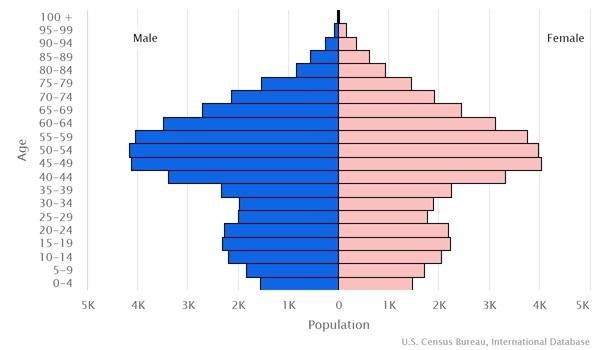
Dependency ratios
total dependency ratio: 38.1
youth dependency ratio: 18.1
elderly dependency ratio: 20.1
potential support ratio: 5 (2021)
Median age
total: 46.2 years
male: 46.3 years
female: 46.1 years (2020 est.)
Population distribution
population is unevenly distributed and is concentrated in the seven urbanized valleys that make up the country's parishes (political administrative divisions)
Urbanization
urban population: 87.8% of total population (2023)
rate of urbanization: 0.11% annual rate of change (2020-25 est.)
Major urban areas - population
23,000 ANDORRA LA VELLA (capital) (2018)
Sex ratio
at birth: 1.07 male(s)/female
0-14 years: 1.06 male(s)/female
15-24 years: 1.04 male(s)/female
25-54 years: 1.05 male(s)/female
55-64 years: 1.1 male(s)/female
65 years and over: 0.9 male(s)/female
total population: 1.05 male(s)/female (2022 est.)
Mother's mean age at first birth
32.8 years (2019)
Infant mortality rate
total: 3.44 deaths/1,000 live births
male: 3.54 deaths/1,000 live births
female: 3.34 deaths/1,000 live births (2022 est.)
Life expectancy at birth
total population: 83.42 years
male: 81.2 years
female: 85.79 years (2022 est.)
Drinking water source
improved: urban: 100% of population
rural: 100% of population
total: 100% of population
unimproved: urban: 0% of population
rural: 0% of population
total: 0% of population (2020 est.)
Current health expenditure
6.7% of GDP (2019)
Physicians density
3.33 physicians/1,000 population (2015)
Hospital bed density
2.5 beds/1,000 population
Sanitation facility access
improved: urban: 100% of population
rural: 100% of population
total: 100% of population
unimproved: urban: 0% of population
rural: 0% of population
total: 0% of population (2020 est.)
Alcohol consumption per capita
total: 10.99 liters of pure alcohol (2019 est.)
beer: 3.59 liters of pure alcohol (2019 est.)
wine: 4.98 liters of pure alcohol (2019 est.)
spirits: 2.32 liters of pure alcohol (2019 est.)
other alcohols: 0 liters of pure alcohol (2019 est.)
Tobacco use
total: 31.8% (2020 est.)
male: 35.3% (2020 est.)
female: 28.3% (2020 est.)
Literacy
definition: age 15 and over can read and write
total population: 100%
male: 100%
female: 100% (2016)
Environment
Environment - current issues
deforestation; overgrazing of mountain meadows contributes to soil erosion; air pollution; wastewater treatment and solid waste disposal
Environment - international agreements
party to: Biodiversity, Climate Change, Climate Change-Paris Agreement, Comprehensive Nuclear Test Ban, Desertification, Hazardous Wastes, Ozone Layer Protection, Wetlands
signed, but not ratified: none of the selected agreements
Air pollutants
particulate matter emissions: 9.95 micrograms per cubic meter (2016 est.)
carbon dioxide emissions: 0.47 megatons (2016 est.)
methane emissions: 0.05 megatons (2020 est.)
Climate
temperate; snowy, cold winters and warm, dry summers
Land use
agricultural land: 40% (2018 est.)
arable land: 1.7% (2018 est.)
permanent crops: 0% (2018 est.)
permanent pasture: 38.3% (2018 est.)
forest: 34% (2018 est.)
other: 26% (2018 est.)
Urbanization
urban population: 87.8% of total population (2023)
rate of urbanization: 0.11% annual rate of change (2020-25 est.)
Revenue from forest resources
forest revenues: 0% of GDP (2018 est.)
country comparison to the world: 160Waste and recycling
municipal solid waste generated annually: 43,000 tons (2012 est.)
Total renewable water resources
315.6 million cubic meters (2017 est.)
Government
Country name
conventional long form: Principality of Andorra
conventional short form: Andorra
local long form: Principat d'Andorra
local short form: Andorra
etymology: the origin of the country's name is obscure; the name may derive from the Arabic "ad-darra" meaning "the forest," a reference to its location as part of the Spanish March (defensive buffer zone) against the invading Moors in the 8th century; an alternate explanation is that the name originates from a Navarrese word "andurrial" meaning "shrub-covered land"
Government type
parliamentary democracy (since March 1993) that retains its chiefs of state in the form of a co-principality; the two princes are the President of France and Bishop of Seu d'Urgell, Spain
Capital
name: Andorra la Vella
geographic coordinates: 42 30 N, 1 31 E
time difference: UTC+1 (6 hours ahead of Washington, DC during Standard Time)
daylight saving time: +1hr, begins last Sunday in March; ends last Sunday in October
etymology: translates as "Andorra the Old" in Catalan
Administrative divisions
7 parishes (parroquies, singular - parroquia); Andorra la Vella, Canillo, Encamp, Escaldes-Engordany, La Massana, Ordino, Sant Julia de Loria
Independence
1278 (formed under the joint sovereignty of the French Count of Foix and the Spanish Bishop of Urgell)
National holiday
Our Lady of Meritxell Day, 8 September (1278)
Constitution
history: drafted 1991, approved by referendum 14 March 1993, effective 28 April 1993
amendments: proposed by the coprinces jointly or by the General Council; passage requires at least a two-thirds majority vote by the General Council, ratification in a referendum, and sanctioning by the coprinces
Legal system
mixed legal system of civil and customary law with the influence of canon (religious) law
International law organization participation
has not submitted an ICJ jurisdiction declaration; accepts ICCt jurisdiction
Citizenship
citizenship by birth: no
citizenship by descent only: the mother must be an Andorran citizen or the father must have been born in Andorra and both parents maintain permanent residence in Andorra
dual citizenship recognized: no
residency requirement for naturalization: 25 years
Suffrage
18 years of age; universal
Executive branch
chief of state: Co-prince Emmanuel MACRON (since 14 May 2017); represented by Patrick STROZDA (since 14 May 2017); and Co-prince Archbishop Joan-Enric VIVES i Sicilia (since 12 May 2003); represented by Josep Maria MAURI (since 20 July 2012)
head of government: Xaviar Espot ZAMORA (since 16 May 2019)
cabinet: Executive Council of 12 ministers designated by the head of government
elections/appointments: head of government indirectly elected by the General Council (Andorran parliament), formally appointed by the co-princes for a 4-year term; election last held on 7 April 2019 (next to be held in April 2023); the leader of the majority party in the General Council is usually elected head of government
election results: 2019: Xaviar Espot ZAMORA (DA) elected head of government; percent of General Council vote - 60.7%
2015: Antoni MARTI elected head of government; percent of General Council vote - 58.3%
Legislative branch
description: unicameral General Council of the Valleys or Consell General de les Valls (a minimum of 28 seats; 14 members directly elected in two-seat constituencies (7 parishes) by simple majority vote and 14 directly elected in a single national constituency by proportional representation vote; members serve 4-year terms); note - voters cast two separate ballots - one for a national list and one for a parish list
elections: last held on 7 April 2019 (next to be held in April 2023)
election results: percent of vote by party - DA 35.1%, PS 30.6%, L'A 12.5%, Third Way/Lauredian Union 10.4%, other 11.4%; seats by party - DA 11, PS 7, L'A 4, Third Way/Lauredian Union 4, other 2; composition - men 15, women 13, percent of women 46.4%
Judicial branch
highest court(s): Supreme Court of Justice of Andorra or Tribunal Superior de la Justicia d'Andorra (consists of the court president and 8 judges organized into civil, criminal, and administrative chambers); Constitutional Court or Tribunal Constitucional (consists of 4 magistrates)
judge selection and term of office: Supreme Court president and judges appointed by the Supreme Council of Justice, a 5-member judicial policy and administrative body appointed 1 each by the coprinces, 1 by the General Council, 1 by the executive council president, and 1 by the courts; judges serve 6-year renewable terms; Constitutional magistrates - 2 appointed by the coprinces and 2 by the General Council; magistrates' appointments limited to 2 consecutive 8-year terms
subordinate courts: Tribunal of Judges or Tribunal de Batlles; Tribunal of the Courts or Tribunal de Corts
Political parties and leaders
Democrats for Andorra or DA [Xaviar ESPOT ZAMORA]
Liberals of Andorra or L'A [Jordi GALLARDO FERNANDEZ]
Social Democracy and Progress or SDP [Victor NAUDI ZAMORA]
Social Democratic Party or PS [Susanna VELA]
Third Way/Lauredian Union [Josep PINTAT FORNE]
United for the Progress of Andorra or UPA [Alfons CLAVERA ARIZTI]
note: Andorra has several smaller parties at the parish level (one is Lauredian Union)
International organization participation
CE, FAO, ICAO, ICC (NGOs), ICCt, ICRM, IFRCS, Interpol, IOC, IPU, ITU, OIF, OPCW, OSCE, UN, UNCTAD, UNESCO, Union Latina, UNWTO, WCO, WHO, WIPO, WTO (observer)
Diplomatic representation in the US
chief of mission: Ambassador Elisenda VIVES BALMANA (since 2 March 2016)
chancery: 2 United Nations Plaza, 27th Floor, New York, NY 10017
telephone: [1] (212) 750-8064; [1] (212) 750-8065
FAX: [1] (212) 750-6630
email address and website:
contact@andorraun.org
Diplomatic representation from the US
embassy: the US does not have an embassy in Andorra; the US ambassador to Spain is accredited to Andorra; US interests in Andorra are represented by the US Consulate General's office in Barcelona (Spain); mailing address: Paseo Reina Elisenda de Montcada, 23, 08034 Barcelona, Espana; telephone: [34] (93) 280-22-27; FAX: [34] (93) 280-61-75; email address: Barcelonaacs@state.gov
Flag description
three vertical bands of blue (hoist side), yellow, and red, with the national coat of arms centered in the yellow band; the latter band is slightly wider than the other 2 so that the ratio of band widths is 8:9:8; the coat of arms features a quartered shield with the emblems of (starting in the upper left and proceeding clockwise): Urgell, Foix, Bearn, and Catalonia; the motto reads VIRTUS UNITA FORTIOR (Strength United is Stronger); the flag combines the blue and red French colors with the red and yellow of Spain to show Franco-Spanish protection
note: similar to the flags of Chad and Romania, which do not have a national coat of arms in the center, and the flag of Moldova, which does bear a national emblem
National symbol(s)
red cow (breed unspecified); national colors: blue, yellow, red
National anthem
name: "El Gran Carlemany" (The Great Charlemagne)
lyrics/music: Joan BENLLOCH i VIVO/Enric MARFANY BONS
note: adopted 1921; the anthem provides a brief history of Andorra in a first person narrative
National heritage
total World Heritage Sites: 1 (cultural)
selected World Heritage Site locales: Madriu-Perafita-Claror Valley
Economy
Economic overview
Andorra has a developed economy and a free market, with per capita income above the European average and above the level of its neighbors, Spain and France. The country has developed a sophisticated infrastructure including a one-of-a-kind micro-fiber-optic network for the entire country. Tourism, retail sales, and finance comprise more than three-quarters of GDP. Duty-free shopping for some products and the country’s summer and winter resorts attract millions of visitors annually. Andorra uses the euro and is effectively subject to the monetary policy of the European Central Bank. Andorra's comparative advantage as a tax haven eroded when the borders of neighboring France and Spain opened and the government eased bank secrecy laws under pressure from the EU and OECD.
Agricultural production is limited - only about 5% of the land is arable - and most food has to be imported, making the economy vulnerable to changes in fuel and food prices. The principal livestock is sheep. Manufacturing output and exports consist mainly of perfumes and cosmetic products, products of the printing industry, electrical machinery and equipment, clothing, tobacco products, and furniture. Andorra is a member of the EU Customs Union and is treated as an EU member for trade in manufactured goods (no tariffs) and as a non-EU member for agricultural products.
To provide incentives for growth and diversification in the economy, the Andorran government began sweeping economic reforms in 2006. The Parliament approved three laws to complement the first phase of economic openness: on companies (October 2007), on business accounting (December 2007), and on foreign investment (April 2008 and June 2012). From 2011 to 2015, the Parliament also approved direct taxes in the form of taxes on corporations, on individual incomes of residents and non-residents, and on capital gains, savings, and economic activities. These regulations aim to establish a transparent, modern, and internationally comparable regulatory framework, in order to attract foreign investment and businesses that offer higher value added.
Real GDP (purchasing power parity)
$3.327 billion (2015 est.)
$3.363 billion (2014 est.)
$3.273 billion (2013 est.)
note: data are in 2012 US dollars
Real GDP growth rate
-1.1% (2015 est.)
1.4% (2014 est.)
-0.1% (2013 est.)
Real GDP per capita
$49,900 (2015 est.)
$51,300 (2014 est.)
$50,300 (2013 est.)
GDP (official exchange rate)
$2.712 billion (2016 est.)
Inflation rate (consumer prices)
-0.9% (2015 est.)
-0.1% (2014 est.)
Credit ratings
Fitch rating: BBB+ (2018)
Standard & Poors rating: BBB (2017)
note: The year refers to the year in which the current credit rating was first obtained.
GDP - composition, by sector of origin
agriculture: 11.9% (2015 est.)
industry: 33.6% (2015 est.)
services: 54.5% (2015 est.)
Agricultural products
small quantities of rye, wheat, barley, oats, vegetables, tobacco, sheep, cattle
Industries
tourism (particularly skiing), banking, timber, furniture
Labor force - by occupation
agriculture: 0.5%
industry: 4.4%
services: 95.1% (2015)
Household income or consumption by percentage share
lowest 10%: NA
highest 10%: NA
Budget
revenues: 1.872 billion (2016)
expenditures: 2.06 billion (2016)
Fiscal year
calendar year
Exports
$78.71 million (2015 est.)
$79.57 million (2014 est.)
note: Data are in current year dollars and do not include illicit exports or re-exports.
Exports - partners
Spain 40%, France 19%, United States 11%, Mauritania 5% (2019)
Exports - commodities
integrated circuits, medical supplies, essential oils, cars, tanned hides (2019)
Imports - partners
Spain 71%, France 17% (2019)
Imports - commodities
cars, refined petroleum, perfumes, shaving products, liquors (2019)
Exchange rates
euros (EUR) per US dollar -
0.885 (2017 est.)
0.903 (2016 est.)
0.9214 (2015 est.)
0.885 (2014 est.)
0.7634 (2013 est.)
Energy
Electricity access
electrification - total population: 100% (2020)
Communications
Telephones - fixed lines
total subscriptions: 40,000 (2020 est.)
subscriptions per 100 inhabitants: 52 (2020 est.)
Telephones - mobile cellular
total subscriptions: 94,000 (2020 est.)
subscriptions per 100 inhabitants: 122 (2020 est.)
Telecommunication systems
general assessment: Andorra has a modern telecommunications system with microwave radio relay connections between the exchanges and land line circuits to France and Spain (2020)
domestic: about 52 per 100 fixed-line, 122 per 100 mobile-cellular (2020)
international: country code - 376; landline circuits to France and Spain; modern system with microwave radio relay connections between exchanges (2019)
note: the COVID-19 pandemic continues to have a significant impact on production and supply chains globally; since 2020, some aspects of the telecom sector have experienced a downturn, particularly in mobile device production; progress toward 5G implementation has resumed, as well as upgrades to infrastructure; consumer spending on telecom services has increased due to the surge in demand for capacity and bandwidth; the crucial nature of telecom services as a tool for work and school from home is still evident, and the spike in this area has seen growth opportunities for development of new tools and increased services
Broadcast media
1 public TV station and 2 public radio stations; about 10 commercial radio stations; good reception of radio and TV broadcasts from stations in France and Spain; upgraded to terrestrial digital TV broadcasting in 2007; roughly 25 international TV channels available (2019)
Internet users
total: 71,084 (2020 est.)
percent of population: 92% (2020 est.)
Broadband - fixed subscriptions
total: 37,000 (2020 est.)
subscriptions per 100 inhabitants: 48 (2020 est.)
Transportation
Military and Security
Military and security forces
no regular military forces; Police Corps of Andorra
Military - note
defense is the responsibility of France and Spain
Transnational Issues
Disputes - international
Andorra-France: none identified
Andorra-Spain: none identified
